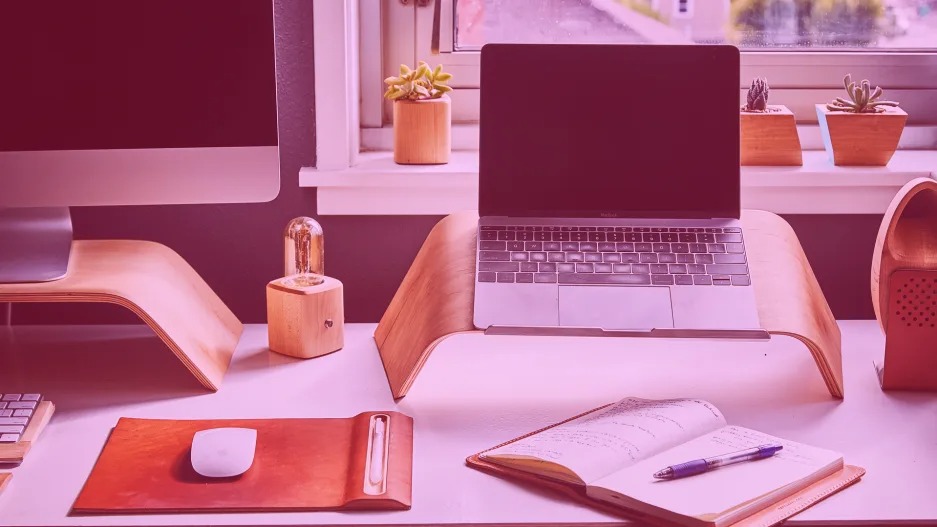- | 9:30 am
How to build a cozy and productive home office even if you’re a hyrbid worker
A home office made up of makeshift components will only help you function productively for so long, says this freelance writer.

A 2021 study from Chicago Booth Review found 40% of employees say working from home is more productive than working in an office.
Some may shake their heads at this, unable to fathom the possibility. And I understand this feeling of skepticism. Personally, it took me many months to establish my own at-home work routine after shifting from an in-office 9-to-5 to freelance work. I spent months experimenting with my schedule and home-office setup to determine what made me most productive during my work hours at home.
Here are some ways you can accomplish the same feat.
DECLUTTER YOUR WORKSPACE FREQUENTLY AND KEEP IT ORGANIZED
Studies show that visual reminders of disorganization drain our cognitive resources and make it difficult to focus. Thus, using your desk as a space to hold nonwork-related items is probably not the best idea. In fact, An Ikea study showed that we spend as many as 5,000 hours during our lives looking for things around the house.
As a result, I consciously try to remove the clutter from my desk daily. Most of the time, I find it better to clear away the accumulated stuff and gradually add things back if and when I need them.
Following a decluttering, I reorganize my essentials, positioning them so they’re always within arm’s reach. Pens, chargers, books, documents, and other things I use daily are displayed. Valet trays (like this option from the company Ugmonk) help me locate each item quickly. Other supplies I don’t need often are kept neatly tucked away in drawers.
PUT YOUR COMFORT FIRST
Labor Department data indicate ergonomic injuries cost workers more productivity and lost time than other types of workplace illnesses.
While looking for a comfortable desk chair when setting up your home office might seem like an obvious first move, it’s not always the case. I opted for a (rather expensive) ergonomic chair from Herman Miller, so it took me a while to save up for this purchase.
Now, I’m not encouraging everyone to opt for high-end home office equipment, but it is important to prioritize your comfort long term. After all, you’ll be spending eight hours a day here, five days a week.
What’s comfortable for you will depend on how you work. A bike or standing desk may be better options if you want to stay active while working.
SET THE MOOD FOR A PRODUCTIVE WORK ENVIRONMENT
Despite being inconvenient most days, commuting often helps prepare you for your workday; not an option when working from home. There’s no seamless flow between home and work life, making it hard to enter and exit “work mode.”
I discovered that setting the mood in my home office helped me create a transitory and more productive experience. A few things that helped me do this:
- Scent and air-quality improvements. Data show quality indoor air increases employee productivity by 8% to 11%. I start by turning on my scent diffuser and adding a few drops of essential oils to create an inviting, productive atmosphere.
- Lighting. When it gets dark early in winter, I set up a decorative yet functional lamp for softer, nonfluorescent lighting. This lamp offers warm, cool, and daylight settings. It helps me complete my tasks on days when my brain tricks me into thinking it’s late afternoon. For me, harsh fluorescent lamps rarely produce this effect.
- Ambient sound. Studies on background music in the workplace showed similar results: Instrumental music boosted workers’ productivity. I prefer soft jazz, white noise, or anything completely lyrics-free through noise-canceling headphones.
DESIGNATE A PLACE FOR RELAXATION AND BRAINSTORMING
As a writer, part of my work is to read and ruminate. This means working doesn’t require me to stay glued to my desk.
When I need a break from the desk chair, I move to a comfortable couch I can lounge on to read my bookmarked tabs or in-depth articles. In her book Writing on Both Sides of The Brain, writer Henriette Anne Klauser highly recommends setting aside a separate area for self-reflection.
It’s also a good idea to create a corner in your home office for brain breaks. Stanford’s Computer Science department examined how working long hours at a time leads to decreased productivity.
When working for extended hours, productivity may deteriorate so much as to become a negative. Aside from adding a comfortable chair, a meditation cushion may be a good addition. Some people’s home offices also have fitness equipment for fitting in a quick workout during downtime.
ADD INSPIRING ACCENTS TO YOUR SPACE
It’s hard to imagine a more pleasant way to increase productivity than by adding your own touches to your workspace. According to a study published in the Journal of Environmental Psychology, personalizing our office gives us a greater sense of control and ownership.
Family photos, art, and other desk accessories make your home office more inviting. Plants, for example, are a good mood booster. In fact, it was found that a few plants placed around the office can significantly benefit concentration in the long run. You’re also likely to spend more time in your home office if you enjoy it. My go-tos are fresh flowers delivered by mail.
These simple tips can help transform how you work from home. Make a few small tweaks and notice the productivity boost you create.








































